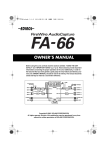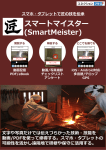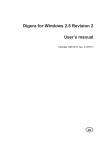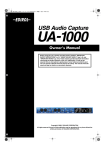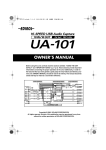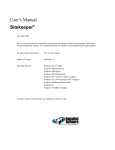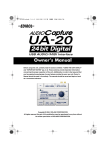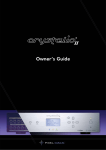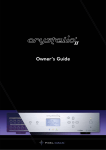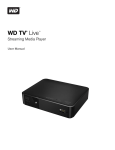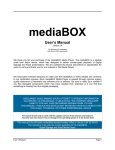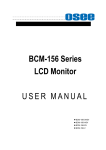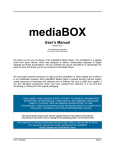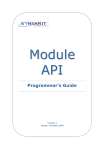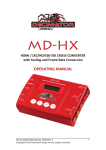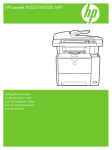Download - Digital Connection
Transcript
Owner's guide Safety Information Important Safety Instructions 1. Read these instructions. 2. Keep these instructions. 3. Heed all warnings. 4. Follow all instructions. 5. Do not use this apparatus near water. 6. Clean only with a dry cloth. 7. Do not block any ventilation openings. Install in accordance with the manufacturer’s instructions. 8. Do not install near any heat sources such as radiators, heat registers, stoves, or other apparatus (including amplifiers) that produce heat. 9. Do not expose this appliance to dripping or splashing water and no object filled with liquids (such as vases) should be placed on this appliance. 10. Do not interfere with the safety aspects of the polarized or grounding-type plug. A polarized plug has two blades with one wider than the other. A grounding type plug has two blades and a third grounding prong. The wide blade or the third prong is provided for your safety. If the provided plug does not fit into your outlet, consult an electrician for replacement of the obsolete outlet. 11. Protect the power cord from being walked on or pinched particularly at plugs and the point where they exit from the apparatus. 12. Only use attachments/accessories specified by the manufacturer. 13. Unplug this apparatus during lightning storms or when unused for long periods of time. 14. Refer all servicing to qualified service personnel. Servicing is required when the apparatus has been damaged in any way, such as if the power-supply cord or plug has been damaged, liquid has been spilled, objects have fallen into the apparatus, the apparatus has been exposed to rain or moisture, does not operate normally, or has been dropped. 2 Additional Safety Instructions • To ensure maximum performance, please read this manual carefully. Keep it in a safe place for future reference • Install this unit in a cool, dry, clean place - away from windows, heat sources, sources of excessive vibration, dust, moisture and cold. Avoid sources of humming (transformers, motors). To prevent fire or electrical shock, do not expose the unit to rain or water • Do not force connection wires. When moving the unit, first disconnect the power plug and the wires connected to other equipment. Never pull on the wires themselves • The openings on the unit cover assure proper ventilation of the unit. If these openings are obstructed, the temperature inside the unit will rise rapidly. Therefore, avoid placing objects against these openings, and install the unit in a well-ventilated area to prevent fire and damage • Be sure to allow a space of at least 30 cm behind, 20 cm on both sides and 10 cm above the top panel of the unit to prevent fire and damage • Digital signals generated by this unit may interfere with other equipment such as tuners, receivers or TVs. Move this unit further away from such equipment if interference is observed • Do not attempt to clean the unit with chemical solvents; this might damage the finish. Use a clean, dry cloth • Be sure to read section 10: Troubleshooting regarding common operating errors before concluding that the unit is faulty • When not planning to use this unit for long periods of time, disconnect the AC power plug from the wall outlet • To prevent lightning damage, disconnect the AC power plug when there is an electrical storm • Grounding or polarization - Precautions should be taken so that the grounding or polarization of an appliance is not defeated • This unit is not disconnected from the AC power source as long as it is connected to the wall outlet, even if this unit itself is turned off. This state is called the standby mode. In this mode, this unit is designed to consume a small amount of power 3 Welcome Thank you for purchasing HD MediaBox. An exciting new world of High-Definition images and audiophile-quality audio is now at your fingertips Viewers can appreciate impressive resolution, dynamic contrast and vivid colors, bringing cinematic excitement and pleasure into the home. HD MediaBox provides the missing link between your HDTV, hi-fi, and computer network. Now, from the comfort of your living room, you can play the movies, music, and photos stored on your computers through your TV and hi-fi. We are confident your new player will both enhance and become integral to your home entertainment system. Before starting, please check the following items were included in your package: 1. HD MediaBox High-Definition Media Player with base attached 2. Auto-Voltage Mains Transformer 3. Power Cord fitted with the correct plug for your region’s domestic power supply 4. HD MediaBox Remote Control with 2 AAA batteries 5. VGA to 3 female RCA (Component Video) conversion cable 6. Composite A/V 3-in-1 Cable (RCA connectors) 7. USB cable 8. A Philips screwdriver and 4 screws for HDD fitting 9. This Owner’s Guide, hard copy or CDROM Please contact your HD MediaBox retailer immediately if any of the above items are missing. 4 Table of Contents Safety Information Important Safety Instructions Additional Safety Instructions Welcome 2 2 3 4 1. About HD Mediabox 1.1 Introducing HD MediaBox 1.2 Features & Functions of HD MediaBox 1.2.1 General 1.2.2 Video Playback 1.2.3 Audio Playback 1.2.4 Photo Display 1.3 An Introduction to High-Definition 1.3.1 HD Format Notation 1.3.2 Interlaced and Progressive 1.4 Supported Formats 1.4.1 A Brief Overview of Video Formats 1.4.2 A Brief Overview of Audio Formats 1.4.3 A Brief Overview of Photo Formats 7 7 7 7 8 8 9 9 10 10 10 10 12 13 2. Familiarizing Yourself with HD MediaBox 2.1 HD MediaBox Case and Stand 2.2 HD MediaBox Front Panel 2.3 HD MediaBox Rear Panel 2.4 HD MediaBox Remote Control 14 14 14 15 16 3. Getting Started 3.1 Connecting Power 3.2 Fitting the Remote Control Batteries 3.3 Adding an Internal Hard Disk Drive (Optional) 3.3.1 Fitting an Internal HDD 3.3.2 Initializing and Formatting an Internal HDD 19 19 19 20 20 22 4. Connections 4.1 Video Connections 4.1.1 High Definition Connections 4.1.2 Standard Definition Connections 4.2 Audio Connections 4.3 Computer Connections 4.3.1 Transferring Files to an Internally Fitted HDD 4.3.2 Connecting External USB Devices 4.3.3 Network Streaming 4.3.3.1 How to Share Folders on Windows XP 4.3.4 Infra Red Distribution 26 26 26 27 28 30 30 31 31 32 33 5 HD MediaBox Setup 5.1 Navigation of the Setup Menus 5.2 Audio Setup 5.2.1 SPDIF Out 34 34 35 36 5 5.3 Video Setup 5.3.1 Active Output 5.3.2 HDMI 5.3.3 SD Modes 5.3.4 HD RGB 5.3.5 HD YPbPr 5.4 System Setup 5.4.1 TV Refresh Rate 5.4.2 TV Shape 5.4.3 Subtitle Encoding 5.4.4 Slideshow 5.4.5 IP Setting (Internet Protocol Setting) 5.4.5.1 How to Input a Static IP Address 5.4.6 Save Profile 5.4.7 Software 36 37 37 38 39 39 40 40 41 41 42 42 43 43 44 6. File Browsing Mode 6.1 Familiarizing Yourself with File Browsing Mode 6.2 Navigating File Browsing Mode 45 45 47 7. Media Playing Mode 7.1 Info Screen 7.2 Repeat 7.3 Zoom 7.4 Time Search and Jump 7.5 Image Adjustments 7.5.1 Brightness 7.5.2 Contrast 7.5.3 Saturation 7.5.4 Vertical Position 7.5.5 Aspect Ratio 7.5.6 Subtitle Delay 7.6 Playlists and Slideshows 7.7 Subtitles 7.8 Other Active Remote Control Keys 48 48 49 49 49 50 51 51 51 51 51 51 52 53 53 8. DVD Playing Mode 8.1 Menu Navigation 8.2 Info Screen 8.3 Repeat 8.4 A-B Repeat 54 54 55 56 56 9. Upgrading Firmware 9.1 Firmware Version Check 9.2 Downloading and Transferring the New Firmware 9.3 Updating HD MediaBox 57 57 57 58 10. Troubleshooting 10.1 Changing Video Output Without an Image 10.2 Recovery from Firmware Corruption 60 61 62 Support & Warranty Information Product Support Product Warranty 63 63 63 6 1. About HD Mediabox 1.1 Introducing HD MediaBox HD MediaBox is a High-Definition HDD (hard disk drive) media player, providing instant access to High-Definition video, digital music, digital photos and DVD files either from its internal hard disk drive (HDD), your personal computer*, USB HDD or Network Attached Storage box*. HD MediaBox supports output resolutions of up to 1080p enabling you to set your HD media free from the constraints of your monitor. Use any VGA, component video, DVI or HDMI equipped display device - Flat panel displays, projectors or HDTVs. For movies, TV shows, camcorder footage and more, HD MediaBox supports all popular formats including MPEG 1/2/4, WMV9, DivX™ and XviD, as well as DVD .ISO and .VOB files. Output everything through the digital HDMI™ connection and you can go digital all the way to your screen! As well as supporting HD files, HD MediaBox will also up-scale and deinterlace your existing standard definition files to match the resolution of your display. HD MediaBox is designed with high quality audio playback in mind. Equipped with 24-bit/192KHz audio DAC from Analog Devices Inc, low noise Op Amps from Burr-Brown® (famous for their clean output and ultra-low distortion characteristics) and our own specially developed timing circuitry, the HD MediaBox can act as a high end hi-fi jukebox, storing thousands of CDs! The Audiophile Edition (MB200) adds a low jitter TCXO (temperature compensated crystal oscillator) to dramatically improve spaciousness, clarity, impact, and purity; providing the highest quality audio playback available in any network media player. Digital optical, coax, and analogue connectors are all provided to deliver this high fidelity audio into any home theater or stereo system. Included with HD MediaBox is a backlit Remote Control so you can keep the lights low. Combined with the small size and fanless operation, you get a high-powered box that's also easy to live with. * Some high bitrate HD video files may not play smoothly across the network. 1.2 1.2.1 Features & Functions of HD MediaBox General User-friendly On Screen Display (OSD). Allows easy navigation using the included Remote Control. All player settings are easily accessible and browsing your files across the network is a cinch. Different media-types are colorcoded and filters can be applied to help with file identification. Flexible Output resolutions. HD MediaBox can output at the following popular resolutions. Digital television standards - 480p, 576p, 720p, 1080i, 1080p PC standards - VGA, SVGA, XGA, SXGA Plasma resolutions - 1366x768, 1280x768 NTSC and PAL support. Full support for PAL and NTSC standard definition formats is included. Simply choose your preferred output in the settings menus (see section 5.4.1). Internal HDD support. An internal IDE hard disk drive can be fitted inside HD MediaBox (see section 3.3). Flexible and comprehensive AV outputs. All the popular methods of connection are supported, including HDMI (v1.1 including embedded audio), Component (YPbPr), VGA, Optical and Coax SPDIF, and more (see section 4). 7 Connectivity options USB: HD MediaBox features three USB2.0 ports. Two of these can be used for connecting external “Mass Storage Devices” which include external USB HDDs, thumbdisks, etc. The other USB port will connect directly to a PC or NAS to allow files to be placed on an internal HDD (if fitted). LAN: An RJ45 is provided to place HD MediaBox on your 10/100BASE-T Ethernet network (100BASE-T recommended). You can now browse shared files and drives on your network which use the SMB protocol (Server Message Block - commonly used by Microsoft Windows). HD MediaBox can also access NAS (Networked Attached Storage) drives on your network if present. (see section 4.3.3) Note that you cannot access an internal HDD (if fitted) from your network - the USB connection is required for this. File system format support. HD MediaBox can read file systems formatted in either FAT32 or NTFS. NTFS is recommended, as FAT32 systems are limited to files less than 4GB in size and High Definition video files very frequently exceed this. Backlit Remote Control. The included Remote Control is backlit to enable use in a darkened ‘home theater’ environment. Updateable firmware. You can update the firmware using the OSD of HD MediaBox. Firmware can be updated from either an internal HDD (if fitted) or an external USB source (a thumbdisk for example). Firmware updates when available can be downloaded from the Support section of the Pixel Magic website (see section 9). 1.2.2 Video Playback Playback of Standard and High Definition video files (see section 1.4.1 for supported formats) Scaling and deinterlacing. This function is performed automatically - all video will be rescaled to match your chosen Output Resolution (see section 5.3 for how to set). For SD material, inverse telecine for film sources and motion adaptive deinterlacing for video sources are supported. For HD material, the ‘bob’ method is used. Example 1: Downscaling and deinterlacing of 1080i to match your 720p display. Example 2: Upscaling and deinterlacing of standard definition to match your 720p display. Auto aspect ratio detection. HD MediaBox can auto-detect whether the source material is 16:9 or 4:3, displaying the video correctly to match the selected aspect ratio of your display. Video streaming across the network. HD MediaBox can access shared folders and drives on your network using the SMB protocol. (see section 4.3.3) External subtitle support. HD MediaBox supports SubRip (.srt) subtitle files. Support for special characters is also included. 1.2.3 Audio Playback Playback of popular audio formats (see section 1.4.2). 24bit/192KHz DAC from Analog Devices. The analog audio stereo output of HD MediaBox features a high performance 24bit/192KHz upsampling DAC from Analog Devices. This increases the resolution of the music, providing a more detailed and natural sound. Precision Clock. The Audiophile Edition (MB200) adds a low jitter TCXO (temperature compensated crystal oscillator) to dramatically improve spaciousness, clarity, impact, and purity. Playlists supported. Text files containing track information can be saved and played automatically (see section 7.6). HDMI audio embedding. Audio can be embedded in the HDMI signal. This provides a digital audio signal to your external DAC (usually included in AV receivers) and reduces cabling. “Play all” in folder option. All files in a folder can be played in alphabetical order with no pauses. 8 1.2.4 Photo Display Playback of High Resolution photographs. Images of any resolution can be displayed; they will be rescaled to match your chosen Output Resolution. See section 1.4.3 for supported formats. Slideshows. HD MediaBox can show all files in a folder alphabetically, or you can create a text file, which lists the order of the photos to be shown (see section 7.6). The length of time each image will be displayed is also adjustable. 1.3 An Introduction to High-Definition High-Definition video or HD video generally refers to any video system of higher resolution than standard-definition (SD). NTSC, PAL and current DVDs are Standard Definition. HD television (HDTV) resolution usually contains either 1080 or 720 lines of video information. In contrast, regular digital television and DVDs are 480 lines (like NTSC) or 576 lines (like PAL/SECAM). High-Definition video generally has an aspect ratio of 16:9 (1.78:1). Standard-definition television (SDTV) has a 4:3 (1.33:1) aspect ratio. HD signals require a High-Definition television or computer monitor in order to be viewed. Many displays are now being marketed as “HD-Ready” but not all can show all of the HD video information. In order to get the most out of HD MediaBox, a display with at least 720 lines is recommended. 9 1.3.1 HD Format Notation HDTV formats are referred to using a notation describing: There are 2 main HD resolutions 720 and 1080. Usually (but not always) HD pixels are square, meaning that if the vertical resolution is 720, to achieve a 16:9 aspect ratio, the horizontal resolution must be 1280. For 1080 the horizontal resolution is usually 1920. Sometimes, for clarity, the full resolutions are written e.g. 1280x720p60. Most HDTV systems support some standard resolutions and frame or field rates. The most common are: 480p60, 576p50, 720p50, 720p60, 1080i50, 1080i60 p = Progressive, i = Interlaced HD MediaBox will initially display in 480p60 as this is THE most commonly supported resolution. A frame or field rate can also be specified without a resolution. For example 60p means 60 progressive frames per second and 50i means 50 fields per second. 1.3.2 Interlaced and Progressive HD formats can be either progressive (p) or interlaced (i). Progressive means each time the image refreshes (60 times a second for NTSC, 50 times a second for PAL) the video signal contains the full resolution. However, with interlacing, each time it refreshes you only get half the resolution (known as a field) - every odd line one field and every even line the next. All SD video formats are interlaced, as is DVD. Obviously progressive scan is the higher quality of the 2 systems, but also has larger file sizes. However, many modern digital display technologies such as Plasma, LCD and DLP inherently progressive scan i.e. they have to show all the lines of resolution at the same time. Somewhere in the video chain, some device has to convert interlaced signals into progressive signals for these displays. This task is called Deinterlacing. Most of these displays will include the technology to do this, however this is a very complex process and HD MediaBox may do a better job. Arguments are common about which looks better - 720p or 1080i? It is common for people to prefer the stability of 720p for subject matter containing a lot of rapid motion (soccer, basketball or hockey games, for example). You may want to experiment in your own setup to see which you prefer. 1.4 1.4.1 Supported Formats A Brief Overview of Video Formats All standard video formats are compressed. The amount of compression and the data rates of these standards vary enormously. Often files made available for download, will be highly compressed (in order to save bandwidth), resulting in a lower image quality. MPEG-1 MPEG-1 is the designation for a group of audio and video coding standards agreed upon by MPEG (Moving Picture Experts Group). 1.5Mbit/second data rates and 352x240 resolution are common with later improvements allowing for up to 4Mbit/second for better quality. 10 MPEG-1 is very common, mainly due to its ability to store an entire film on a single CD. This Video CD format is a mass-market competitor to VHS in countries where high humidity can quickly degrade magnetic tapes. Common file extensions .mpg Streaming over the 100BASE-T and USB2.0 supported YES MPEG-2 MPEG-2 is the designation for a group of audio and video coding standards agreed upon by MPEG (Moving Picture Experts Group). MPEG-2 video is not optimized for low bit-rates (less than 1 Mbit/s), but outperforms MPEG1 at 3 Mbit/s and above. MPEG-2 is typically used for standard definition DVDs (maximum average of 9.8 Mbit/s) and television broadcasts (commonly a lower bit rate than DVD). Some High-Definition files are also coded using MPEG-2, and higher bit rates do exist. Common file extensions .mpg .m2v Streaming over the 100BASE-T and USB2.0 supported YES MPEG-4 MPEG-4 is the designation for a group of audio and video coding standards agreed upon by MPEG (Moving Picture Experts Group). In general, MPEG-4 video will look more natural than MPEG-2 at the same bit rate (all else being equal). This has made it an incredibly popular format for bandwidth-sensitive applications such as online steaming, web downloads and television broadcasting. Common file extensions* .avi .mp4 Streaming over the 100BASE-T and USB2.0 supported YES WMV9/WMVHD/VC-1 Windows Media Video (WMV) is a generic name for the set of proprietary streaming video technologies developed by Microsoft. It is a non-standard version of MPEG-4 Part 2. WMVHD is a new addition to the technology that adds High Definition resolutions. VC-1 is an informal name for the draft SMPTE standard 421M codec which is a superset of WMV-9 and WMVHD. Common file extensions* .wmv .avi Streaming over the 100BASE-T and USB2.0 supported YES DivX™ and XviD DivX and XviD uses MPEG-4 Part 2 compression. They are popular because their codecs (software to compress the video and audio) are made available without charge. Quality can be as good as MPEG-4, but it is common for already compressed files to be recompressed with these codecs, resulting in further loss of image quality. Common file extensions* .avi Streaming over the 100BASE-T and USB2.0 supported YES 11 DVD .ISO An ISO image (.iso) is an informal term for a disk image of an ISO 9660 file system. Most CD/DVD authoring utilities can create these kinds of files. In general these behave exactly as a DVD disc would when put into a DVD player. Common file extensions* .iso Streaming over the 100BASE-T and USB2.0 supported YES DVD .VOB and .IFO A VOB file (DVD-Video Object) is a file type contained in DVD-Video media. It contains the actual Video, Audio, Subtitle and Menu contents in stream form. The maximum size of VOB files is 1GB and are therefore found in multiples, in conjunction with .IFO and .BUP files. An .IFO is a DVD information file that stores information about Chapters, Subtitles and Audio Tracks. In general, when the VIDEO_TS.IFO file is accessed, it will behave exactly as a DVD disc would when inserted into a DVD player. VOB files can also be accessed directly. Common file extensions* .vob .ifo Streaming over the 100BASE-T and USB2.0 supported YES .TS This stands for Transport Stream and is an MPEG-2 video stream. It is used by some HDTV broadcasters and is gaining popularity as a high quality High-Definition file format. Common file extensions* .ts .tp Streaming over the 100BASE-T and USB2.0 supported YES † * A file extension on a file (such as .avi) does not mean that the data within that file is compatible with the player. Many file formats use similar file extensions, and it is not necessarily an indication of what the file encoding format is. HD MediaBox supports many types of file format, but due to encoding differences, not all files may play. † Some high bitrate HD video files may not play smoothly across the network. 1.4.2 A Brief Overview of Audio Formats HD MediaBox supports a mixture of both compressed and uncompressed audio formats. Recently, as computer storage costs have greatly reduced, lossless compression has become increasingly popular among those who can discern the differences. MP3 MP3 was developed by the Moving Picture Experts Group (MPEG). The name MP3 stands for MPEG 1 Audio Layer 3 (see section 1.4.1). It is by far the most commonly used compressed audio format. Like most modern ‘lossy’ audio compression, the MP3 process is modeled on the human hearing range. MP3 tries to reduce file size by first removing sounds from the frequency extremes. Common file extensions* .mp3 Streaming over the 100BASE-T and USB2.0 supported YES 12 AAC (Advanced Audio Coding) Also called MPEG-2 AAC or MPEG-2 NBC, this audio codec is the logical continuation of the MP3 codec created by Fraunhofer-Gesellschaft. Due to advances in technology, AAC files encoded at a 96 kbps bit rate sound slightly better than MP3s encoded at 128 kbps. The AAC codec entered the mainstream when Apple announced that the iTunes Music Store would sell its digital music downloads in AAC format. Copy protected AAC files are not supported by this player. Common file extensions* .aac .m4a Streaming over the 100BASE-T and USB2.0 supported YES WAV or WAVE A format developed by Microsoft and IBM for storing high quality, uncompressed audio. WAV became the standard on PCs, but because of the large file sizes it requires (about 10MB per minute of music), most people convert WAV files to compressed formats (MP3, WMA, and so on). Common file extensions* .wav Streaming over the 100BASE-T and USB2.0 supported YES WMA Windows Media Audio is a ‘lossy’ format similar to MP3 and AAC. This is essentially a competing format created and licensed by Microsoft. Microsoft claims that Windows Media files are even better than MP3 files, and is now positioned as a competitor to the AAC format. Common file extensions* .wma Streaming over the 100BASE-T and USB2.0 supported YES * A file extension on a file (such as .avi) does not mean that the data within that file is compatible with the player. Many file formats use similar file extensions, and it is not necessarily an indication of what the file encoding format is. HD MediaBox supports many types of file format, but due to encoding differences, not all files may play. 1.4.3 A Brief Overview of Photo Formats JPEG and JPG JPEG (pronounced jay-peg) is by far the most commonly used method of compression for photographic images. Although a ‘lossy’ format, most digital cameras are able to save files at a compression level hard to detect. Overlycompressed files can suffer from artifacts such as ‘blocking’, ‘smearing’ and ‘blurring’. These are similar to those found in low bit rate DVDs and Video CDs. BMP The name is short for bitmap and these files can be saved at various bit-depths. This relates to the number of colours shown in the image and is commonly saved at 24-bit (referred to as true-color). 24-bit BMP files are lossless but are much larger in file size than JPEGs. These files are used internally by the Microsoft Windows graphics subsystem (GDI). GIF These are very common on the Internet and mostly used for line art and areas of flat colour (logos, buttons and diagrams for example). GIF files keep edges clearly defined, but JPEG is much better for photographic images PNG PNG (Portable Network Graphics) is a lossless compressed bitmap image format. PNG was created to both improve upon and replace the GIF format with an image file format not requiring a patent license to use. PNG is officially pronounced "ping" and, like GIFs and BMPs, reduces file size by reducing the number of colours. PNGs can also be 24-bit true-color and maintain all the original image information, similarly to BMPs though, file sizes will be large. 13 2. Familiarizing Yourself with HD MediaBox 2.1 HD MediaBox Case and Stand HD MediaBox is fanless by design, and does not require any additional cooling, even if an internal HDD is fitted. Care should be taken however, to ensure that HD MediaBox is not placed in very hot environments or spaces without any airflow. Cooling holes are included in the HD MediaBox case and attention should be taken not to cover these holes during operation. HD MediaBox arrives fitted with a stand for use in the vertical position. However, HD MediaBox can also be used horizontally without interfering with operation. This is achieved simply by removing the included base using a flat blade screwdriver. To provide adequate ventilation, it is recommended that small rubber feet are used on the bottom surface. 2.2 HD MediaBox Front Panel Power indicator The power status of HD MediaBox is shown by the color of the LED No light - No mains power Red - Standby Green - Running Play/Pause indicator This blue LED shows the playback status of HD MediaBox. No light - No media is playing Blue constant light - Media is playing Blue flashing light - Media is paused Hard disk indicator This orange LED shows when the internal HDD (if fitted) is being accessed; either by HD MediaBox or by an external PC via USB. It is normal for this light to flicker during disk accessing No light - HDD is not being accessed Orange light - HDD is being accessed USB 2.0 indicator This Blue LED shows when HD MediaBox is accessing an external USB storage device through one of its 2 USB ports. No light - External USB storage is not being accessed Blue light - External USB storage is being accessed Infra Red (IR) input sensor This is where HD MediaBox receives its instructions from the Remote Control. Care should be taken to avoid blocking this area. 14 2.3 HD MediaBox Rear Panel USB PC Ext. IR Composite S-Video Audio L Audio R Coax Digital audio Optical HDMI RGBHV or YPbPr 2x USB 1 USB 2.0 to PC This allows HD MediaBox to be connected to a PC using the included USB cable. Once connected, the PC will detect the internal HDD (if fitted) as an external USB Mass Storage Device and files can be managed like any other HDD (see section 4.3.1). 2 Infra Red In/Out for room-to-room Remote Control If HD MediaBox is not placed in sight of the Remote Control, this port can be used to connect to an IR distribution system (see section 4.3.4). 3 Composite Video Output This is the most basic of video connections and is Standard Definition only. 4 S-VIDEO Output S-Video offers a higher quality signal than Composite for compatible equipment but is Standard Definition only. 5 Analog Audio Output (left/Right) All audio on this port has benefited from a 24bit/192KHz upsampling DAC and can carry Dolby ProLogic and ProLogic II formats (to a compatible decoder). 6 Coaxial Digital Audio Output LAN 12V DC 7 Optical Digital Audio Output 8 HDMI (v1.1) Digital A/V Output The HDMI (High Definition Multimedia Interface) can carry video and embedded audio, and provides the best quality video and audio output from HD MediaBox. If you are connecting to a display device that has an HDMI terminal, this is the recommended option to use. This allows direct transmission of the video information from HD MediaBox to the display without any digital to analogue conversion. Always use high quality HDMI cables, especially for longer cable runs. An HDMI > DVI cable can be used to connect HD MediaBox to a compatible DVI-equipped device. 9 VGA Output This port can be configured in the setup menus to output 2 signal formats. These offer superior quality over Composite and S-Video, and can send High Definition signals to compatible equipment. • RGBHV (often referred to as VGA) • YPbPr (often referred to as Component Video) 10 RJ45 Ethernet Network Connection Allows HD MediaBox to be connected to a computer network for playing media files stored on shared folders or network servers. 10 and 100-BASE-T networks are supported; however 100-BASE-T is recommended as the bandwidth is more suited to common HD MediaBox tasks. 11 USB 2.0 X 2 for Mass Storage Devices Allows HD MediaBox to be upgraded using a USB thumbdisk and expanded by attaching external USB drives for additional media storage. 12 Power Adapter Input Please use the 12v auto-sensing unit supplied with HD MediaBox. 15 2.4 HD MediaBox Remote Control Power On/Off Pressing this key toggles the power of HD MediaBox on/off. Mute Pressing this key toggles the audio output of HD MediaBox on/off. Alpha/Numeric keys These keys enter alpha/numeric values in appropriate areas (e.g. during a Time Search). In Media Playing Mode, pressing the numeric keys during playback will access different parts of the file. Pressing 0 will jump to the start of the file; 1 will jump to a point 10% of the total playing time; 2 will jump to 20%; 3 will jump to 30%; etc MEDIA In File Browsing Mode, pressing this key cycles through the “Display file type:” options Video/Photo/Music/All (see section 6.1). INFO In Media Playing Mode and DVD playing Mode, pressing this key displays an info panel displaying information about the file being played (see section 7.1 for Media Playing Mode and section 8.2 for DVD Playing Mode). Rewind / Rotate Photo Counter-clockwise When viewing video, pressing this key rewinds the media being played. Pressing it multiple times will increase the speed of the rewind. An icon is displayed on the screen, to indicate the current speed. The Play/Pause key must be pressed to stop rewinding. When viewing a photo, pressing this key will rotate the image 90 degrees counter-clockwise. Forward / Play Folder / Rotate Photo Clockwise In File Browsing Mode, pressing this key plays the media files in the currently highlighted folder. When viewing video, pressing this key forward winds the media being played. Pressing it multiple times will increase the speed of the forward wind. An icon is displayed on the screen, to indicate the current speed. The Play/Pause key must be pressed to stop rewinding. When viewing a photo, pressing this key will rotate the image 90 degrees clockwise. Previous In File Browsing Mode, pressing this key goes back one page of the file list. In Media Playing Mode, pressing this key plays the previous media file. In DVD Playing Mode, pressing this key plays the previous chapter. Next In File Browsing Mode, pressing this key goes forward one page of the file list. In Media Playing Mode, pressing this key plays the next* media file. In DVD Playing Mode, pressing this key plays the next chapter. * In Media Playing Mode, the sequence of next media file depends on the Repeat Mode setting (see section 7.2 for more information) 16 MENU In DVD Playing Mode, pressing this key enters the MAIN MENU of the DVD. TITLE In DVD Playing Mode, pressing this key enters the TITLE MENU of the DVD (if present). SUBTITLE In Media Playing Mode when playing .ts files and in DVD Playing Mode, pressing this key cycles through the SUBTITLES (if present). AUDIO In DVD Playing Mode, pressing this key cycles through the AUDIO TRACKS of the DVD (if more than one). VOLUME +/Pressing this key changes the output volume of HD MediaBox. The default value is 16 and you can leave it at this setting if you plan to use your amplifier to change the volume. If a Mini Menu has been activated (e.g. Brightness, Contrast, Profile, Zoom, etc), pressing these keys will adjust the value of the setting. PROFILE Pressing this key will recall a saved profile (see section 5.4.6). Pressing the key multiple times will cycle through the currently used profile numbers (1-10). TV Modes Pressing this key during playback will show the current resolution on the screen. Pressing a NUMBER key within 5 seconds will change the output resolution as follows: 1. Composite/S-video/Component (from 15pin VGA port) in 480i 2. HD YPbPr component (from 15pin VGA port) 480p 3. HD RGB (from 15pin VGA port) 480p 4. HDMI 480p 5. HDMI 720p 6. HDMI 1080i To select another resolution, press TV Modes followed by another NUMBER key. Play/Pause In File Browsing Mode, pressing this key will play all media files listed in the current folder. In Media or DVD Playing Modes, pressing this key will toggle between PLAY and PAUSE. Stop In Media or DVD Playing Modes, pressing this key will STOP the file (or playlist) and return to File Browsing Mode. Up/Down/Left/Right In File Browsing Mode, pressing these keys will move the highlighted item. In DVD Playing Mode, pressing these keys will navigate the DVD menu screens. OK In File Browsing Mode, pressing this key will select the currently highlighted item or open the currently highlighted folder. In DVD Playing Mode, pressing this key will select the currently highlighted item on DVD menu screens. 17 Up Folder In File Browsing Mode, pressing this key will navigate up one level to the parent folder. In Media or DVD Playing Modes, pressing this key will return the Zoom to normal (unzoomed). Setup In File Browsing Mode, pressing this key will open the Setup Menu. In Media or DVD Playing Modes, pressing this key will cycle through the following sliders. • • • • • • Brightness Contrast Saturation Vertical Position Aspect Ratio Subtitle Delay Use the Volume +/- keys to adjust the values of each slider. REPEAT In Media Playing Mode, pressing this key will cycle through the following Repeat Modes: • • • • Track - repeats the current media file All - repeats all the media files in the current folder Random - repeats all the media files randomly in the current folder Cleared - no repeat In DVD Playing Mode, pressing this key will cycle through the following Repeat Modes: • • • • Track - repeats the current chapter All - repeats the whole DVD Random - repeats all chapters randomly Cleared - no repeat A-B In DVD Playing Mode: • Pressing this key once will select point A • Pressing this key again will select point B DVD video will loop continuously from point A to point B ZOOM In Media and DVD Playing Modes, pressing this key once will enter Zoom Mode and go to Zoom Level 1 (enlarged video/photo). Repeatedly pressing the ZOOM key will cycle through the Zoom Levels from 0 to 31. Once Zoom Mode has been activated you can use VOL+ and VOL- to control the level of zoom. While in Zoom Mode, pressing the Up Folder Remote Control key returns the zoom level to 0 (off). When HD MediaBox finishes playing the current file, the zoom level resets to 0 (off), except during a slideshow of photos, when the zoom level remains unchanged. ANGLE In DVD Playing Mode, pressing this key cycles through the viewing ANGLES of the DVD (if present). SEARCH In Media and DVD Playing Modes, pressing this key displays a numeric entry box, which allows the media playing point to be set. Use the Numeric Keys to enter a specific time in hh:mm:ss format (e.g. 2 hours, 17 minutes, 26 seconds would be entered as 02:17:26). When the OK key is pressed, the media file will start playing from the specified time. 18 3. Getting Started 3.1 Connecting Power Caution: Use the 12v auto-sensing unit supplied with HD MediaBox. Ensure that the cable provided is suitable for the power supply in your country. Contact your dealer immediately if you require an alternative power connector. step 1 Connect the standard IEC power cord into the back of the auto-sensing power supply. step 2 Then connect the 12v power connector to the back of HD MediaBox as shown in the diagram. step 3 Plug the power cord into your power outlet and switch on. You will see a green light on the power supply and a red LED on the front of HD MediaBox to confirm power. Press the 3.2 key on the Remote Control to turn HD MediaBox on. Fitting the Remote Control Batteries step 1 step 2 Turn the Remote Control over Remove the battery compartment cover by placing your thumb in the indent, and carefully sliding it backwards. step 3 step 4 Insert 2 AAA batteries (provided) in the slots taking special care to line the positive (+) and negative (-) ends of the batteries with the diagram inside the compartment. Replace the cover by sliding it horizontally from the back of the Remote Control. It will click firmly into place. step 5 Quickly test your batteries by pressing any key - all the keys should light blue. 19 3.3 Adding an Internal Hard Disk Drive (Optional) HD MediaBox supports one internally fitted IDE Windows formatted Hard Disk Drive (HDD). The IDE interface is UATA100 and is backwards compatible with lower speed interfaces. Future IDE interfaces may also be backwards compatible with HD MediaBox. Please check the manufacturer’s specification for details. HD MediaBox can read file systems formatted in either FAT32 or NTFS. NTFS is recommended, as FAT32 systems are limited to files less than 4GB in size and High Definition video files frequently exceed this. 3.3.1 Fitting an Internal HDD To fit an IDE HDD, follow these simple steps: step 1 step 2 step 3 Before you start, make sure you have a) a flat clear space to work on, free of dust, dirt and moisture b) a Philips screwdriver (included with HD MediaBox) c) the 4 HDD screws (included with HD MediaBox) d) a supported IDE HDD Make sure all cables are disconnected from HD MediaBox, including the power supply. Remove the 3 screws shown in the diagram. step 4 step 5 Carefully hold the edges of the back panel and slide it out backwards. The internal circuitry and HDD cage will come out with it. Lay the cage on your workspace with the rear panel towards you and the power connector on the left. A B C step 6 step 7 Take your HDD and make sure the jumper is set to either MASTER or CABLE SELECT. Turn your HDD so that the base (with screw holes) is facing up and the connectors are on the right. continued overleaf 20 step 8 Carefully slide your HDD into the cage from the left as show in the diagram. The base of the HDD should be touching the top plate. Make sure point X and Y are aligned. X Y step 9 step 10 Insert the 4 HDD screws into the holes shown in the diagram and tighten. Turn the cage around so that you can see the HDD connectors. step 11 There are 2 connectors, 1 on a ribbon cable (the IDE cable) and one with 4 wires (the POWER cable). Connect both these cables to your HDD. step 12 step 13 Carefully slide the cage back into the case, by lining up the plates and grooves as shown in the diagram Re-insert the 3 screws into the rear panel of HD MediaBox. The internal HDD is now ready for use. If the HDD is not formatted, please see the next section. 21 3.3.2 Initializing and Formatting an Internal HDD Caution: Formatting a disk will erase all data currently stored. If your HDD is NEW, you may need to do one or more of the following tasks • Initialize • Partition • Format Under Windows XP, you can make a partition and format the HDD using the Disk Manager utility. • HD MediaBox can only read the first (Primary) partition on an internally fitted HDD. • HD MediaBox can read file systems formatted in either FAT32 or NTFS. NTFS is recommended, as FAT32 systems are limited to files less than 4GB in size and High Definition video files very frequently exceed this. step 1 First follow the steps in section 4.3.1 to connect HD MediaBox to your computer. step 2 Press the Start button, right-click My Computer and select Manage from the pop-up menu - the Computer Management utility will appear step 3 In the left hand menu choose Disk Management and you will see a list of Hard Disks appear on the right. 22 step 4 Right click the Unallocated disk and from the pop-up menu select New Partition to start the New Partition Wizard. step 5 Press Next > and select Primary Partition. Press Next > again. step 6 In the Specify Partition Size section, enter the maximum available size (FAT32 partitions are limited to 32,000MB) and press Next >. 23 step 7 In the Assign Drive Letter or Path section, select a letter from the list and press Next >. step 8 In the Format Partition section, select your preferred File system (NTFS is recommended) and press Next >. step 9 When completed, detailed information will appear as shown below. Click the Finish button to complete the Wizard and start the formatting process. (Please wait until the completion of the formatting process) 24 step 10 The Disk Management utility will now show the file system as ‘Healthy’ and the internal HD MediaBox HDD is ready for use (see section 4.3.1). 25 4. Connections The following connection types are listed in order of quality. For best results, please use the highest quality connection that your display device allows. Always use high quality cables for your connections, particularly over long runs, to preserve the high quality output that HD MediaBox provides. 4.1 4.1.1 Video Connections High Definition Connections HDMI HDMI (cable not included) HDMI HDMI (High-Definition Multimedia Interface) is a digital connection and offers the highest quality image quality from HD MediaBox. If your display device has an HDMI connection, it is recommended that you use this method. The HDMI connector can also carry embedded digital audio, so if you intend to use your display’s speakers or your amplifier/receiver supports HDMI, this method will result in fewer cables. DVI HDMI (cable not included) DVI DVI (Digital Visual Interface) is a common connection on High Definition displays. You can connect HD MediaBox to a DVI-equipped display by using the HDMI connector with an HDMI-to-DVI cable. The information carried over DVI is exactly the same as HDMI and there is no loss of signal quality using the method. 26 VGA (RGBHV) VGA (cable not included) VGA VGA (cable not included) RGBHV Many High Definition display devices support VGA. It is a high quality analog connection with every element of the signal (Red, Green, Blue, Horizontal Sync and Vertical Sync) transmitted through its own cable to prevent interference. You can connect a VGA cable to HD MediaBox using the VGA connector. If your display features separate R, G, B, H and V connectors you can use a VGA to RGBHV cable. Check to see if your display or processor requires BNC or RCA connectors, as both are common. High Definition Component (YPbPr) VGA breakout cable (included) Standard Component cable (not included) This connection is made using the VGA connector and the supplied breakout cable. Simply connect the included breakout cable to the HD MediaBox VGA connector and then use a standard Component cable to link the breakout cable to your display or AV receiver. 4.1.2 Standard Definition Connections Component (YPbPr) VGA breakout cable (included) Standard Component cable (not included) This connection is made using the VGA connector and the supplied breakout cable. Simply connect the included breakout cable to the HD MediaBox VGA connector and then use a standard Component cable to link the breakout cable to your display or AV receiver. 27 S-VIDEO S-Video (cable not included) S-Video S-Video is a video format that works by separating the color (Chrominance) and brightness (Luminance) parts of the video signal. This result in less interference than with the two combined (as is the case with Composite Video). COMPOSITE VIDEO Composite (cable included) Composite Composite Video is the standard video connector format. Its name is derived from the fact that all color and brightness information is combined and passed through a single cable. This connection is provided for maximum compatibility, but is not recommended for your primary viewing connection. 4.2 Audio Connections All Audio outputs (including HDMI embedded digital audio) are active simultaneously. DIGITAL AUDIO If you want to use an external device to decode the digital audio (e.g. Dolby Digital) the Digital Audio Outputs will need to be used to connect HD MediaBox to a compatible display/receiver/amplifier. In this instance, the Digital to Analog Conversion is performed externally to HD MediaBox. The HD MediaBox digital audio outputs are of equal performance - choose which to use based on compatibility and convenience. Coaxial Digital Audio Coaxial (cable not included) Coaxial 28 Optical Digital Audio Optical (cable not included) Optical HDMI Embedded Digital Audio HDMI (cable not included) HDMI (cable included) Analog L+R ANALOG AUDIO Analog L+R Analog audio is 2-channel and can have Dolby ProLogic and ProLogic II encoded into the signal to provide surround sound. HD MediaBox will down-mix digital multi-channel audio to provide an analog stereo output. When the analog audio outputs are used, the Digital to Analog Conversion is performed by the high quality DAC onboard HD MediaBox. You may want to experiment when listening to 2-channel music, to see which provides the highest quality conversion; HD MediaBox or your receiver/amplifier. 29 4.3 Computer Connections HD MediaBox provides multiple ways of accessing your media files. You can fit an internal HDD (see section 3.3); connect external storage devices via USB 2.0; stream your files from a computer network, or use a combination of these for maximum flexibility. 4.3.1 Transferring Files to an Internally Fitted HDD First make sure an Internal HDD has been fitted as per section 3.3. step 1 Plug HD MediaBox into the mains near your PC step 2 Make sure HD MediaBox is in Standby Mode ( step 3 Connect the included USB cable to the back of HD MediaBox as shown in the diagram. POWER LED will be RED) USB cable included step 4 Connect the other end of the included USB cable to your PC or USB hub. The blue the front panel of HD MediaBox will light to show the presence of a USB connection. step 5 USB LED on In Windows XP, cancel any Autorun options and you will now see the following screen. Choose “Open folder to view files using Windows Explorer” and you will now see the contents of the HD MediaBox internal HDD. step 6 Copy or move files between HD MediaBox and your PC as you would any other folder. While files are copying you will see the orange MediaBox flash to show activity. HDD LED and the blue USB LED on the front of HD When you have finished transfering files, it is important to 'Safely Remove Hardware' to prevent file corruption. Double-click the icon in your PC's taskbar and follow the on-screen instructions. The USB cable needs to be disconnected from HD MediaBox for it to POWER ON and play media files. 30 4.3.2 Connecting External USB Devices External USB Hard Disk Drive USB thumbdisk HD MediaBox supports the use of USB 1.0 and USB 2.0 Mass Storage Devices. This term can refer to thumbdiscs, external HDDs with a USB interface and other devices that are seen by HD MediaBox as file storage. HD MediaBox streams the media across the USB interface, therefore the increased bandwidth of USB 2.0 is recommended. USB devices can be connected to, and disconnected from HD MediaBox at any time. However, if a device is removed while HD MediaBox is accessing the drive for playback, HD MediaBox will stop the file and return to File Browsing Mode. Up to 2 USB devices can be connected to HD MediaBox. 4.3.3 Network Streaming network cables not included HD MediaBox can be used to enjoy your existing collection of videos, photos and music by accessing shared files, folders and drives over your Local Area Network (LAN).* HD MediaBox uses the SMB protocol (Server Message Block - commonly used by Microsoft Windows) to stream files across the network and this is also supported by many NAS (Networked Attached Storage) drives. A 10/100 Ethernet port (a 100BASE-T network is recommended) is included on the back of the unit, and HD MediaBox will automatically configure itself via the DHCP protocol (see section 5.4.5). Simply connect a network cable between HD MediaBox and your router before turning on HD MediaBox. You cannot use the LAN to access the files stored on an HD MediaBox internal HDD - the USB connection is provided for this function (see section 4.3.1). * Some high bitrate High Definition video files may not play smoothly across the network. 31 4.3.3.1 How to Share Folders on Windows XP step 1 Locate the folder you wish to share. Right-click on the folder and select ‘Sharing and Security’ from the popup menu. step 2 Check ‘Share this folder on the network’ and type a share name (this is the name that HD MediaBox will see). step 3 After pressing ‘OK’, the shared folder icon will now have a hand under it as shown below. If you are using Windows XP Professional and you have disabled "Simple File Sharing", you need to set the permissions for the shared folders correctly. Please refer to your Windows manual if necessary. 32 If your PC has a personal firewall installed, please make sure that the firewall is configured to allow other LAN users to access the shared folders in your PC. Please refer to your personal firewall manual if necessary. 4.3.4 Infra Red Distribution Instead of using the IR receiver on the front panel of HD MediaBox, it may be convenient to use an Infra Red distribution system. This will enable HD MediaBox to be controlled without being directly in sight of the Remote Control. Mini-jack (cable not included) Mini-jack Connect your Infra Red distribution system to HD MediaBox using an IR extension cable (not included). 33 5 HD MediaBox Setup 5.1 Navigation of the Setup Menus Following connection of HD MediaBox to your display and audio devices, you will need to correctly configure the settings to ensure you get the best possible video and audio output. Make sure that your display device is connected and switched on. After HD MediaBox has been switched on you will see the HD MediaBox logo, followed by the File Browser. If you don’t see an image at this point, please refer to section 10: Troubleshooting. Press the key on your Remote Control to enter Setup Mode. 34 In general, you will only need to use the keys to navigate the setup menus. If you want to exit Setup and return to File Browsing Mode at any time, simply press the Control again. 5.2 key on your Remote Audio Setup After entering Setup Mode, press the on your Remote Control. 35 5.2.1 SPDIF Out SPDIF (Sony/Philips Digital Interface Format) is a protocol to govern the data transferred using the Digital Audio Outputs of HD MediaBox. PCM: This is a stereo digital signal that a wide variety of devices can understand. Use this option if you DON’T have a decoder/receiver/amplifier that can decode digital multi-channel audio signals. Bit stream: This option streams the data directly from the media file, unconverted, ready for decoding by an external decoder/receiver/amplifier. Use this option if you DO have a decoder/receiver/amplifier that can decode digital multi-channel audio signals. This setting has no effect on the Analog Audio Outputs. 5.3 Video Setup After entering Setup Mode, press the then the on your Remote Control to highlight Video, to enter the Setup Menu. 36 5.3.1 Active Output Active Output sets lets you choose which Video Output HD MediaBox should use. HDMI: Choosing this will activate the HDMI (High Definition Multimedia Interface) port. SD: Choosing this will change the VGA port to Standard Definition Component Video (YPbPr). HD YPbPr: Choosing this will set the VGA port to High Definition Component output (YPbPr). HD RGB: Choosing this will set the VGA port to High Definition RGBHV output. 5.3.2 HDMI This setting is applied if HDMI has been selected as your Active Output (see section 5.3.1). HD MediaBox provides both HDTV resolutions and Computer resolutions for maximum compatibility. It is recommended that you choose a resolution to match the native resolution of your display device as closely as possible. 1080p is the highest resolution that HD MediaBox will output. 37 Auto EDID (Extended Display Identification Data): If this option is selected, HD MediaBox will attempt to ‘talk’ to the display device over the HDMI interface and determine its native resolution. If the resolution cannot be determined, HD MediaBox will set it’s output to 640x480 at 60Hz. In this instance, please set the resolution manually. 480p: This is a progressive output of 720x480 720p: This is a progressive output of 1280x720 1080i: This is an interlaced output of 1920x1080 1080p: This is a progressive output of 1920x1080 All the following options are progressive: 1366x768 1280x1024 1280x768 1024x768 800x600 640x480 5.3.3 SD Modes Currently this menu option is for information only. If the TV Refresh Rate (see section 5.4.1) is set at 60Hz, SD output will automatically be set to 480i (PAL) and if 50Hz is chosen, SD output will automatically be set to 576i (PAL) 38 5.3.4 HD RGB The following formats are sent to your display if HD RGB has been selected as your Active Output (see section 5.3.1). 480p: This is a progressive output of 720x480 720p: This is a progressive output of 1280x720 1080i: This is an interlaced output of 1920x1080 1080p: This is a progressive output of 1920x1080 All the following options are progressive: 1366x768 1280x1024 1280x768 1024x768 800x600 640x480 5.3.5 HD YPbPr 39 The following formats are sent to your display if HD YPbPr has been selected as your Active Output (see section 5.3.1). 480p: This is a progressive output of 720x480 720p: This is a progressive output of 1280x720 1080i: This is an interlaced output of 1920x1080 1080p: This is a progressive output of 1920x1080 5.4 System Setup After entering Setup Mode, press the then the 5.4.1 twice on your Remote Control to highlight System, to enter the Setup Menu. TV Refresh Rate Use this setting to choose the output refresh rate of HD MediaBox. Your Standard Definition display may accept only one of these settings (usually 60Hz in America and Japan and 50Hz in the rest of the World). 40 Modern digital displays will probably support both refresh rates, but may have a preference. Refer to your display’s manual for more information. HD MediaBox will automatically set SD outputs to PAL if 50Hz is chosen and NTSC if 60Hz is chosen. 60Hz 50Hz 5.4.2 TV Shape Make sure this setting corresponds to the physical shape of your display. The numbers refer to the Aspect Ratio of the display - width:height. 4:3: Use this setting if your display is not widescreen. 16:9: Use this if you have either a) a widescreen display b) a 4:3 display which has a 16:9 mode activated (refer to your display’s manual). This setting is saved as part of a Profile (see section 5.4.6). 5.4.3 Subtitle Encoding Use this section to select the Subtitle encoding method suitable for your media files and language choice. 41 UTF8: Unicode GB2312: Chinese Simplified Big5: Chinese Traditional Western: Western European See section 7.7 for an explanation of subtitle use in Media Playing Mode. This setting is saved as part of a Profile (see section 5.4.6). 5.4.4 Slideshow This setting defines the amount of time a photo is displayed for when Off: The photo will stay on until you press either the Remote Control keys. STOP, is selected in File Browsing Mode. PREVIOUS, or NEXT 5 seconds: Each photo is displayed for 5 seconds then moves to the next* file. 10 seconds: Each photo is displayed for 10 seconds then moves to the next* file. * In Media Playing Mode, the sequence of next media file depends on the Repeat Mode setting (see section 7.2 for more information) 5.4.5 IP Setting (Internet Protocol Setting) This setting is required for HD MediaBox to detect your network (if present). 42 DHCP (Dynamic Host Configuration Protocol): If your network includes a DHCP server (e.g. a broadband router), HD MediaBox can automatically detect the network when this option is selected. Static: Use this setting in a DHCP server is not present. 5.4.5.1 How to Input a Static IP Address If you don't have a DHCP server (e.g. a broadband router), you need to set the IP address of HD MediaBox manually for network access. step 1 Select Setup > System > IP Setting > Static and you will be presented with the following pop-up screen. step 2 Use the number keys on the Remote Control to enter the IP Address and Subnet Mask in the boxes provided. Press step 3 when you have finished. Reboot HD MediaBox for it to be seen on the network (see section 5.4.7). 5.4.6 Save Profile This menu option allows you to save some of the HD MediaBox settings, for later recall. The settings saved in each profile are: 43 • • • • • Brightness Contrast Saturation Subtitle Encoding TV Shape When a Profile number is highlighted, a hint at the bottom of the screen will say whether the profile is already used and if so, what the current settings are. This feature is useful for use with different media types, from different sources, where settings are likely to vary from file to file. Profiles can be recalled during playback by pressing the 5.4.7 key on the Remote Control. Software Default: Selecting this will return all HD MediaBox settings to their default factory settings (Firmware version will remain the same) Upgrade: Selecting this will start the firmware upgrade process (see section 9). Reboot: Selecting this will reboot (restart) HD MediaBox. This should be done after a change in IP Settings. 44 6. File Browsing Mode When HD MediaBox is idle, it is in File Browsing Mode. Here, you can browse and select your audio, video and photo files to play. These can be stored in any of the following locations. • An internal hard disk (if fitted) • Shared Drives on your Local Area Network • NAS (Network Attached Storage) drives • External USB devices such as external hard discs or USB thumbdiscs 6.1 Familiarizing Yourself with File Browsing Mode 1 3 2 4 5 6 1. Current Folder path: This area shows how you’ve drilled down to get to the current folder. 2. Current folder contents: This area displays the contents of the current folder. Each page can show up to 9 items. Each item is given an icon and a color according to the following two tables. 45 3. Filters: Selecting one of these icons will limit the ‘Current folder contents’ to files of that type. The “Play all” function will also be limited to files of that type. e.g. If is selected, only video files will show in the file browser. If is pressed, HD MediaBox will play all the video files in the current folder. Created: and Size: These areas show the date the currently selected file was created and its size. 4. Up Folder: This navigates back up one level, to the parent folder. 5. Play all: This button will play all files in the current folder, one by one. Note that the sequence in which the files will be played depends on the Repeat Mode setting (see section 7.2): Track - repeats the current media file All - repeats all the media files in the current folder Random - repeats all the media files randomly in the current folder Cleared - no repeat 6. Previous Page and Next Page: These buttons will navigate to more files in the current folder. The current page number and total page numbers are shown to the right. File Browser Colors White Folder, drive or location Green Video files Yellow Music files Pink Photo files File Browser Icons The internal Hard Disk A Local Area Network (LAN) A PC on your LAN The HD MediaBox USB connections A folder in any drive (internal, USB or shared across the network) A video file A DVD IFO or ISO file (see section 1.4.1) A supported subtitle file An audio file A photo file 46 6.2 Navigating File Browsing Mode In general, you will only need to use the keys can make navigation easier. keys to navigate the File Browser. However these additional MEDIA - Pressing this key cycles through the “Display file type:” options Video/Photo/Music/All (see section 6.1). Previous - Pressing this key goes back one page of the file list. Next - Pressing this key goes forward one page of the file list. Play/Pause - Pressing this key will play all media files listed in the currently OPEN folder. Up Folder - In File Browsing Mode, pressing this key will navigate up one level to the parent folder. Forward / Play Folder - Pressing this key plays the media files in the currently highlighted folder. 47 7. Media Playing Mode After selecting a particular media file or files to play, HD MediaBox will enter Media Playing Mode. If the file is a DVD .ISO or .IFO, HD MediaBox will enter DVD Playing Mode (see section 8). When the file reaches the end (or the last file reaches the end if “Play All”, and Repeat Mode is defined), HD MediaBox will return to File Browsing Mode. 7.1 Info Screen While playing audio files, the following info screen is displayed. While viewing video files, pressing the key on the Remote Control displays the following information panel. Both these panels show the following information about the file being played. 48 • • • • • Name File Size Repeat Mode (see section 7.2) Total length (in hh:mm:ss format) Time played so far (in hh:mm:ss format) 7.2 Repeat In Media Playing Mode, pressing this key will cycle through the following Repeat Modes: • Track - repeats the current media file • All - repeats all the media files in the current folder • Random - repeats all the media files randomly in the current folder • Cleared - no repeat The current Repeat Mode is shown on the ‘now playing’ and ‘info’ screens. 7.3 Zoom Pressing the key once during playback will enter Zoom Mode and go to Zoom Level 1 (enlarged video/photo). Repeatedly pressing the key will cycle through the Zoom Levels from 0 to 31. Once Zoom Mode has been activated you can use While in Zoom Mode, pressing the to control the level of zoom. Remote Control key returns the zoom level to 0 (off). When HD MediaBox finishes playing the current file, the zoom level resets to 0 (off), except during a slideshow of photos, when the zoom level remains unchanged. This feature is not active when playing audio-only files. 7.4 Time Search and Jump Pressing the key during playback displays a pop-up panel with a numeric entry box. This allows the media playing point to be set. Use the NUMBER keys on the Remote Control to enter a specific time in hh:mm:ss format (e.g. 2 hours, 17 minutes, 26 seconds would be entered as 02:17:26). When the key is pressed, the media file will start playing from the specified time. Another way to jump to a different part of the current file is to use the NUMBER keys. Pressing 0 will jump to the start of the file; 1 will jump to a point 10% of the total playing time; 2 will jump to 20%; 3 will jump to 30%; etc 49 7.5 Image Adjustments Pressing the key during playback will cycle through the following sliders. • Brightness • Contrast • Saturation • Vertical Position • Aspect Ratio • Subtitle Delay Use the keys or the keys to adjust the values of each slider. These adjustments are not active when playing audio-only files. 50 7.5.1 Brightness The Brightness setting adjusts the Black Level of HD MediaBox. HD MediaBox has been properly calibrated for Black Level at the factory and it is first recommended that you try the ‘default’ level and adjust your display to match. If a suitable image cannot be obtained, this HD MediaBox adjustment may help. Black Level (Brightness) should be set at the point where black areas of the image look black AND where you can see the difference between black and near-black. It is recommended that you use properly designed test material, but if you don’t have a test pattern for adjusting black level, select a scene with lots of dark areas (for example, a man wearing a black jacket in a dark night background), and adjust the Brightness. Use a variety of files and formats to get a good balance. The default value = 16 7.5.2 Contrast The Contrast setting adjusts the White Level of HD MediaBox. HD MediaBox has been properly calibrated for White Level at the factory and it is first recommended that you try the ‘default’ level and adjust your display to match. If a suitable image cannot be obtained, this HD MediaBox adjustment may help. White Level (Contrast) should be set at the point where white areas of the image look white AND where you can see the difference between white and near-white. It is recommended that you use properly designed test material, but if you don’t have a test pattern for adjusting white level, select a scene with lots of light areas (for example, a sunny sky with a little bit of cloud), and adjust the Contrast. Use a variety of files and formats to get a good balance. The default value = 16 7.5.3 Saturation Saturation is the level of color added to the B&W signal. HD MediaBox has been properly calibrated for Saturation at the factory and it is first recommended that you try the ‘default’ level and adjust your display to match. If a suitable image cannot be obtained, this HD MediaBox adjustment may help. The aim is to achieve a colorful but natural level of saturation. Use a variety of files and formats to get a good balance. The default value = 16 7.5.4 Vertical Position This setting will move the image vertically up and down the display The default value = 16 7.5.5 Aspect Ratio This works in co-operation with the Setup > System > TV Shape setting, so make sure this is set correctly first. By default, HD MediaBox will automatically detect the Aspect Ratio (shape) of the played file. However, if the file is unusually encoded, this setting may help correct the shape manually. 4:3 - The source file is Square format 16:9 - The source file is Widescreen format The default setting is = Auto detect. 7.5.6 Subtitle Delay If the subtitles aren’t displayed in sync with the video image, this setting can help to align them. The adjustments are made in 0.5 second steps and can be positive or negative. The default value = 0.0s 51 7.6 Playlists and Slideshows HD MediaBox can play multiple files in sequence - if these files are photos, this is often called a slideshow. If the files in a playlist are photos, they will be shown for the amount of time set in Setup > System > Slideshow. Playlists can be initiated in 3 different ways: Play all: To play multiple files in a sequence, select the ‘Play all’ function when in a folder - this will play the all the files in sequence. You can control the the media types played by using the filters (see section 7.1) and the orders in which they are played by setting the Repeat Mode (see section 7.2) once the file is playing. Using this method, the first file played will be the first file in the folder (alphabetically). The selected Repeat Mode will determine the order of subsequent files. Repeat Mode: Once a file is playing, you can select a Repeat Mode by pressing the key on your Remote Control. If Random or All is selected, HD MediaBox will move onto the next file after it has finished playing the current file. Using this method, you can specifically choose the first file to play. The selected Repeat Mode will determine the order of subsequent files. Autoplay: When HD MediaBox is turned on, it searches for a file named autoplay.txt in the root of an external USB device (if connected) and then the internal HDD (if fitted). This autoplay.txt file can contain a list of files for HD MediaBox to play. HD MediaBox will immediately start playing the first file from the list and then play subsequent files in the order that they appear. You can create an autoplay.txt file using the following format: \samplefolder1\samplemovie.avi \samplefolder2\samplesong.mp3 \samplefolder1\samplephoto.jpg The backslash at the beginning of these lines indicates that the files are in the same drive as the autoplay.txt If you want files to play from different drives, the following format can be used. usb\samplemovie.avi hdd\samplefolder2\samplesong.mp3 net\pcname\sharedfoldername\samplephoto.jpg usb\ = file is stored on an external USB device hdd\ = file is stored on the internal HDD net\ = file is stored on a shared location on the network Important notes: Only one USB drive can be connected for the autoplay function to work (it can be in either USB slot). If the drive is formatted to FAT16 or FAT32 (as is common on thumbdiscs), the file and folder names can only be 8.3 format (an 8 character name followed by a 3 character file extension, e.g. testfile.jpg). 52 7.7 Pressing the Subtitles key cycles through the subtitles of the media file (if present). Subtitle encoding is currently supported for .ts files. For a subtitle file to be available during playback, the files must be in the same folder as the video file and start with the same name as the video file, for example: If the video file is named samplevideo.ts The subtitle files must be named as follows: samplevideo.english.srt samplevideo.chinese.srt The ‘english’ and ‘chinese’ text in the examples above will be the names displayed when the during playback. 7.8 key is pressed Other Active Remote Control Keys Rewind / Rotate Photo Counter-clockwise When viewing video, pressing this key rewinds the media being played. Pressing it multiple times will increase the speed of the rewind. An icon is displayed on the screen, to indicate the current speed. The Play/Pause key must be pressed to stop rewinding. When viewing a photo, pressing this key will rotate the image 90 degrees counter-clockwise. Forward / Rotate Photo Clockwise When viewing video, pressing this key forward winds the media being played. Pressing it multiple times will increase the speed of the forward wind. An icon is displayed on the screen, to indicate the current speed. The Play/Pause key must be pressed to stop rewinding. When viewing a photo, pressing this key will rotate the image 90 degrees clockwise. Previous Pressing this key plays the previous media file. Next Pressing this key plays the next media file (the sequence of next media file depends on the Repeat Mode setting see section 7.2 for more information) AUDIO Pressing this key cycles through the AUDIO TRACKS of the media file (if more than one). 53 8. DVD Playing Mode An example of DVD menu navigation After selecting a DVD .ISO or .IFO file, HD MediaBox will enter DVD Playing Mode. When is pressed HD MediaBox will return to File Browsing Mode. Most controls and features in this Mode are similar to Media Playing Mode (see section 7), with the following differences: 8.1 Menu Navigation Unlike the other media types played by HD MediaBox, DVD files have their own menu system and navigational structure. Use the following keys to navigate your DVD files. Up/Down/Left/Right Pressing these keys will navigate the DVD file menu screens. OK Pressing this key will select the currently highlighted item on menu screens. Previous Pressing this key plays the previous chapter. Next Pressing this key plays the next chapter. MENU Pressing this key enters the MAIN MENU of the DVD. This is the menu that also appeared when the DVD file first started playing. TITLE Pressing this key enters the TITLE MENU of the DVD (if present). 54 SUBTITLE Pressing this key cycles through the SUBTITLES of the DVD (if present). The name of the Subtitles will be visible in the top-right of the screen. AUDIO Pressing this key cycles through the AUDIO TRACKS of the DVD (if more than one). The name of the Audio Tracks will be visible in the top-right of the screen. ANGLE Pressing this key cycles through the viewing ANGLES of the DVD (if present). The name of the Angle will be visible in the top-right of the screen. 8.2 Info Screen While viewing DVD files, pressing the key on the Remote Control displays the following information panel. This panel shows the following information about the file being played. • Title (Total): The DVD Title Number and the Total Number of Titles. • Chapter (Total): The DVD Chapter Number and the Total Number of Chapters. • Chapter Time: The time played in the current chapter in hh:mm:ss format. • Audio Output: The Audio Output as set in Setup > Audio > SPDIF Out (see section 5.2.1). • Video Output: The video resolution as set in Setup > Video (see section 5.3). • TV Shape: The TV Shape as set in Setup > System > TV Shape (see section 5.4.2). • Repeat Mode: The currently selected Repeat Mode (see section 8.3). • Audio (Total): The name of the currently selected Audio Stream and the total available on the DVD. • Subtitle (Total): The name of the currently selected Subtitles and the total available on the DVD. • Angle (Total): The name of the currently selected Angle and the total available on the DVD. 55 55 8.3 Repeat In DVD Playing Mode, pressing the • • • • key will cycle through the following Repeat Modes: Track - repeats the current chapter All - repeats the whole DVD Random - repeats all chapters randomly Cleared - no repeat The current Repeat Mode is shown on the ‘info’ screen. 8.4 A-B Repeat DVD video files can loop continuously from point A to point B. This feature can be useful during calibration. During playback, pressing the key once will select point A Pressing this key again will select point B. HD MediaBox will now loop continuously from point A to point B. 56 9. Upgrading Firmware Firmware is a name given to the software stored inside HD MediaBox - it controls the functionality of HD MediaBox. It is important that your firmware is up-to-date, as new features, bug fixes, and enhanced operation may be available for your player. New HD MediaBox firmware will be available on the Pixel Magic Support Download section and the Support Forums. http://www.pixelmagicsystems.com/support/downloads/firmware/index.htm http://www.pixelmagicforum.com/forum The firmware for HD MediaBox will be called MediaBox.bin and will be contained within a .zip file. Upgrade your firmware by following these simple steps: 9.1 Firmware Version Check step 1 Enter the SETUP menu by turning on HD MediaBox then pressing the step 2 The current firmware version will be displayed in the bottom right hand corner of the screen. key on the Remote Control. step 3 If the firmware available for download is newer than the version installed in your HD MediaBox (i.e. a higher version number), continue to the next section 9.2 Downloading and Transferring the New Firmware If the firmware available for download is newer than the version installed in your HD MediaBox, follow these steps to bring your firmware up-to-date. step 1 Download the new firmware zip file from the Pixel Magic website (links above) to a PC. step 2 Unzip the file and you should see a file called MediaBox.bin step 3 Connect HD MediaBox to this PC via the included USB cable (see section 4.3.1). step 4 Connect HD MediaBox to a power socket and leave it in Standby Mode. step 5 Your PC will detect HD MediaBox as an external drive (and assign it a drive letter). step 6 Copy the newly downloaded MediaBox.bin file into the ROOT (i.e. not inside any folders) of the HD MediaBox internal HDD. 57 9.3 Updating HD MediaBox step 1 Connect your HD MediaBox to your display in the normal way. step 2 Navigate to SETUP > System > Software and highlight the Upgrade option. step 3 At the bottom of the screen you will see a confirmation message if MediaBox.bin has been put in the correct location. If the firmware was found - select Upgrade step 4 You will see a pop-up message asking you for confirmation Caution: it is important that the power to HD MediaBox is not interrupted during the upgrade process. If power is interrupted you may need to use the recovery process outlined in section 10.2. 58 HD MediaBox will now start the firmware upgrade process and you will see a progress bar and percentage. After HD MediaBox has completed upgrading the firmware, it will automatically reboot. Congratulations. Your HD MediaBox is now ready for use - Please refer to the new firmware instructions to learn about any new features or operational changes. 59 10. Troubleshooting Problem Possible Cause Solution No Picture • HD MediaBox is not plugged in • Check power cable is connected as per section 3.1. And that a green light is showing on the front panel of HD MediaBox. • HD MediaBox has not been switched on using the Remote Control. • USB>PC cable is still connected • Video cables are not connected • Your display is not capable of accepting a 480p signal. • Ensure that the USB>PC cable is disconnected before starting HD MediaBox • Ensure the correct video cables are connected between the display device and HD MediaBox (see section 4.1). • Check that your display is capable of accepting a 480p signal. If it is not, follow the instructions in section 10.1 to change the video output. Network not working • Ethernet cable is not connected • Wrong network type selected • IP address settings incorrect • No shared folders or drives available on your network • Check the network cable is plugged in on both HD MediaBox and your network hub. A link light should show up on HD MediaBox if the cable is connected correctly. • Refer to section 5.4.5 to check your IP settings in the Network settings page. • Make sure that you have setup at least one shared folder or drive on your network and that it is not password protected. HD MediaBox cannot obtain IP Address • DHCP server not running • Ensure that there is a server or device that acts as a DHCP server on your network if you have set DHCP in the IP Setting menu. Remote Control not working • No batteries, or batteries are flat. • Ensure that there are 2 AAA size batteries in the Remote Control and they are inserted correctly (see section 3.2). • Infra Red Receiver on HD MediaBox is obstructed • Replace the batteries • Ensure that the front panel of HD MediaBox is not obstructed by any objects and that you are pointing the Remote Control directly at HD MediaBox. continued overleaf 60 Problem Possible Cause Solution File does not play • Encoding problem • Check that the file you are attempting to play is encoded in a format that is supported by HD MediaBox (see section 1.4.1). Some files do not display • File format is not supported • Check that the file you are trying to find has a supported file extension and is in a format supported by HD MediaBox (see section 1.4.1). No sound • Audio cables are not connected • Ensure that the audio cables are connected correctly between the HD MediaBox and your audio device (see section 4.2). • Wrong output type is selected • Ensure that you have selected the correct output type for your audio connections (see section 5.2.1). USB device not found • Device not supported • Device partition type is not supported • Ensure that the device you are connecting is a “Mass Storage Device”. • Ensure that your device is formatted as either FAT32 or NTFS 10.1 Changing Video Output Without an Image Problem: No video output or unreadable video output. Explanation: By default, HD MediaBox outputs 480p from the HDMI port, if on startup your display can’t read this signal, you may need to change the output resolution and format without being able to see the image. Solution: You can change the output signal using the Remote Control and the front panel LEDs. step 1 Setup and turn on HD MediaBox by connecting power and a connection to your display. step 2 Turn on HD MediaBox by pressing the step 3 The step 4 Pressing the step 5 Pressing a NUMBER key within 5 seconds will directly select the output resolution as follows: 1. 2. 3. 4. 5. 6. key on the Remote Control. LED will light up blue during startup and then turn off once it is ready to use. key on the Remote Control will start the POWER LED flashing between green and red. Composite/S-video/Component (from 15pin VGA port) in 480i HD YPbPr component (from 15pin VGA port) 480p HD RGB (from 15pin VGA port) 480p HDMI 480p HDMI 720p HDMI 1080i To select another resolution, repeat steps 4 and 5. 61 10.2 Recovery from Firmware Corruption Problem: HD MediaBox becomes unresponsive and doesn’t start. LED lights blue, but the blue POWER LED turns to green and LED remains constantly lit and File Browser doesn’t display. Explanation: This can occur if a firmware upgrade was interrupted or other firmware corruption has occurred. Solution: The following steps allow you to reset HD MediaBox without using the on screen menus. step 1 Transfer a known working version of the firmware onto the internal HDD using the instructions in section 9.2 or to an external USB device. Ensure that only one version of the firmware exists on any connected drives. step 2 Remove the power connector from HD MediaBox, wait 5 seconds and re-insert the power connector. step 3 Make sure HD MediaBox is in standby mode ( connected to a PC via USB. POWER LED is red) and that HD MediaBox is no longer step 4 Point the Remote Control directly at the HD MediaBox IR receiver and press the step 5 Press and hold the step 6 HD MediaBox will now begin the firmware upgrade process. The blue 1 long 1 short 1 long 2 short 1 long 3 short 1 long 4 short 1 long 5 short key until the key. POWER LED turns green. LED will flash in the following pattern to show progress. = 0-19% = 20-39% = 40-59% = 60-79% = 80-100% After completion, HD MediaBox will shutdown and can be started in the usual way. 62 Support & Warranty Information Product Support HD MediaBox is designed to provide you with many years of viewing pleasure. If for any reason you encounter a problem with your HD MediaBox unit, please follow these steps: 1. 2. 3. 4. 5. Carefully follow the instructions shown in this manual. Refer to Section 10: Troubleshooting to try and rectify the problem. Contact your dealer for advice. Use the Pixel Magic Support Forum http://www.pixelmagicforum.com If you still cannot get the information you need, please contact our support team using the following details. Email: [email protected] International Support Hotline: (852) 2607 4078 Caution: Under NO circumstances should you attempt to repair or modify your HD MediaBox unit as this could expose you to electrical shock, and/or severely damage your HD MediaBox. Product Warranty Pixel Magic Systems Ltd. warrants HD MediaBox for One-Year from date of purchase to the original purchaser that this product is free from defects in materials and workmanship. If, after inspection, you discover any defects in materials or workmanship, Pixel Magic Systems Ltd. will have the option to repair, or replace the defective Pixel Magic Systems’ product free of charge. This one-year warranty does not cover damages from normal wear and tear or from accidental damage, misuse, improper care, alterations or damage caused in transportation by a common carrier or airline. There are no other warranties expressed or implied, including, but not limited to, the implied warranties of merchantability and the fitness for a particular purpose beyond the terms of this one-year warranty. The one-year warranty offered by Pixel Magic Systems Ltd. herein may not be modified by any oral representations made by any employee, agent or representative of Pixel Magic Systems Ltd. Repair or replacement as provided under this warranty is the exclusive remedy of the consumer. Pixel Magic Systems Ltd. shall not be liable for any incidental or consequential damages for breach of any expressed or implied warranty on this product, except to the extent prohibited by applicable law, any implied warranty of merchantability or fitness for a particular purpose on this product is limited in duration to the duration of this warranty. If you need to have your Pixel Magic Systems’ product repaired or replaced under the conditions of this one-year warranty, please contact your dealer to make suitable arrangements. Limitation of Liability (for all customers) BOTH YOURS AND PIXEL MAGIC SYSTEMS’ LIABILITY SHALL BE LIMITED TO THE PRICE PAID FOR PRODUCT. IN NO EVENT SHALL EITHER YOU OR PIXEL MAGIC SYSTEMS LTD. BE LIABLE TO THE OTHER FOR ANY INDIRECT, SPECIAL, INCIDENTAL OR CONSEQUENTIAL DAMAGES RESULTING FROM PERFORMANCE OR FAILURE TO PERFORM UNDER THIS AGREEMENT, OR USE OF ANY GOODS OR SERVICE SOLD PURSUANT HERETO, WHETHER DUE TO A BREACH OF CONTRACT, BREACH OF WARRANTY, NEGLIGENCE, OR OTHERWISE. NEITHER YOU NOR PIXEL MAGIC SYSTEMS LTD. SHALL HAVE ANY LIABILITY TO THE OTHER FOR INDIRECT OR PUNITIVE DAMAGES, OR FOR ANY CLAIM BY ANY THIRD PARTY EXCEPT AS EXPRESSLY PROVIDED HEREIN. 63 © Copyright 2006 Pixel Magic Systems Ltd. HD MediaBox™ is a trademark of Pixel Magic Systems Ltd. All rights reserved. DivX™ is a trademark of DivXNetworks, Inc. HDMI (High Definition Multimedia Interface) is a trademark of HDMI Licensing LLC. BURR-BROWN® is a registered trademark of Texas Instruments Incorporated. Specifications and features subject to change without notice.

































































